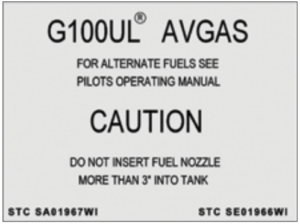If you’ve paid much attention to general aviation industry news, you’ve probably heard of the recently announced EAGLE initiative involving the FAA and some industry groups. The initiative’s purpose derives from its acronym: Eliminate Aviation Gasoline Lead Emissions. Outgoing FAA Administrator Steve Dickson and the industry groups identified in the graphic below announced the effort in late February. The EAGLE initiative’s ultimate goal is to “safely eliminate the use of leaded aviation fuel by the end of 2030 without adversely affecting the existing piston-engine fleet.” Which is admirable. But there are a couple of problems.
First among them is the overwhelming sense of déjà vu I get from the idea the FAA and industry are banding together to resolve the leaded fuel problem. That’s because we’ve all been down this path before with something called PAFI, the Piston Aviation Fuel Initiative (PAFI), which goes back at least as far as 2014. It fell apart in 2018 when the agency suspended its evaluation efforts. Since then, nothing much has happened at the federal level or among industry groups.
While the FAA and the alphabet soup risked what a cynical observer might label a delay of game penalty with PAFI, environmentalists and others with genuine concerns about the only remaining mobile source of lead pollution in the air haven’t been idle. California’s Santa Clara County banned 100LL on January 1, 2022. The avgas available at the county’s two airports—Reid-Hillview (RHV) and San Martin (E16)—is Swift Fuels’ UL94, which is only suitable for relatively low-powered piston aircraft. It’s fine for the O-235 in my Aeronca but the IO-520 in my Debonair can’t use it. (Well, the Deb can use it once.) And I’m hearing rumors that other communities—not just in California—are contemplating similar actions.
The U.S. Environmental Protection Agency (EPA) hasn’t been idle, either. The agency’s web site has this to say: “EPA is now evaluating, under the Clean Air Act, whether emissions of lead from piston-engine aircraft cause or contribute to air pollution that endangers public health or welfare. For convenience, we refer to this action collectively as the ‘endangerment finding.’
“EPA currently plans to issue a proposed endangerment finding in 2022 which will undergo public notice and comment. After evaluating comments on the proposal, we plan to issue any final endangerment finding in 2023.”
Those of us with long memories recognize the phrase “endangerment finding.” It stems from the U.S. Clean Air Act, first enacted in 1963. If the EPA finds that lead endangers “public health or welfare,” which it likely will, the Clean Air Act requires the agency to take steps to control such emissions. Although the FAA is recognized as the only federal agency with authority to regulate aircraft and their operation, how that will turn out could hinge on the federal courts, which haven’t been setting new consistency standards lately.
But all of this could be made academic. As I enthusiastically discussed in this space for our September 2021 issue, there already is an unleaded aviation gasoline approved by the FAA for numerous aircraft/powerplant combinations: G100UL, from General Aviation Modifications, Inc. (GAMI). Last year at EAA’s AirVenture fly-in, GAMI was awarded an approved model list (AML) supplemental type certificate (STC). That AML was quickly expanded in October to include over 600 piston aircraft engines.

Since then, GAMI has said its existing AML/STC package would be further expanded to include all FAA-certified spark-ignition powerplant/airframe combinations, even my Debonair and its IO-520. Put aside the technical/engineering and political feat that is, and think about how it would upend the traditional general aviation marketplace. The word on the street is that GAMI’s work continues on-schedule for final approval. In other words, the FAA/industry EAGLE initiative isn’t necessary and certainly can be successfully concluded well before 2030. Unless something else is going on.
What might that be? Despite the long-term decline in piston aircraft operations and general aviation, umm, generally, there’s still a lot of life left there. In other words, people are still spending money on piston-powered aircraft, and those aircraft still need fuel. As a consumer-electronics executive once told me, “Market share is everything.”
Imagine what you might do if a company with no prior experience or track record in your industry came up with a better mousetrap to compete against your company’s market-leading pest-control products. Imagine further that your hypothetical company had no hesitation implementing a delaying strategy to preserve its market share. You might enlist the help of a well-meaning federal agency and industry groups. How would that scenario differ from what the EAGLE initiative is set to do over the next seven years?
— Jeb Burnside




